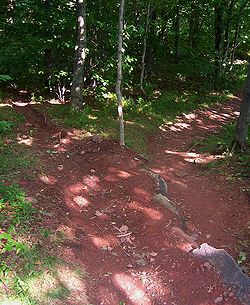
Waterbar
Encyclopedia

Erosion
Erosion is when materials are removed from the surface and changed into something else. It only works by hydraulic actions and transport of solids in the natural environment, and leads to the deposition of these materials elsewhere...
on sloping roads, cleared paths through woodland (for utility companies such as electricity pylons), or other accessways by reducing flow length. It is a diagonal channel across the road surface that diverts surface water that would otherwise flow down the whole length of the road, gaining velocity, off the road and into a stable drainway. By constructing a series of water bars at intervals along a road, the volume of erosive water flowing down the road is reduced. Without waterbars, flood
Flood
A flood is an overflow of an expanse of water that submerges land. The EU Floods directive defines a flood as a temporary covering by water of land not normally covered by water...
ing, washouts, and accelerated road degradation can occur.
The drainway carries the water that would otherwise be carried by the road. Thus for proper operation of the water bars it must be stable and regularly inspected to ensure that it is free of silt buildup or other obstructions.

Four Wheel Drive
The Four Wheel Drive Auto Company, more often known as Four Wheel Drive or just FWD, was founded in 1909 in Clintonville, Wisconsin, as the Badger Four-Wheel Drive Auto Company by Otto Zachow and William Besserdich.-History:...
vehicle is required. Waterbars are common on roads such as Forest Service Roads, especially in mountainous terrain where lots of rainfall occurs.

